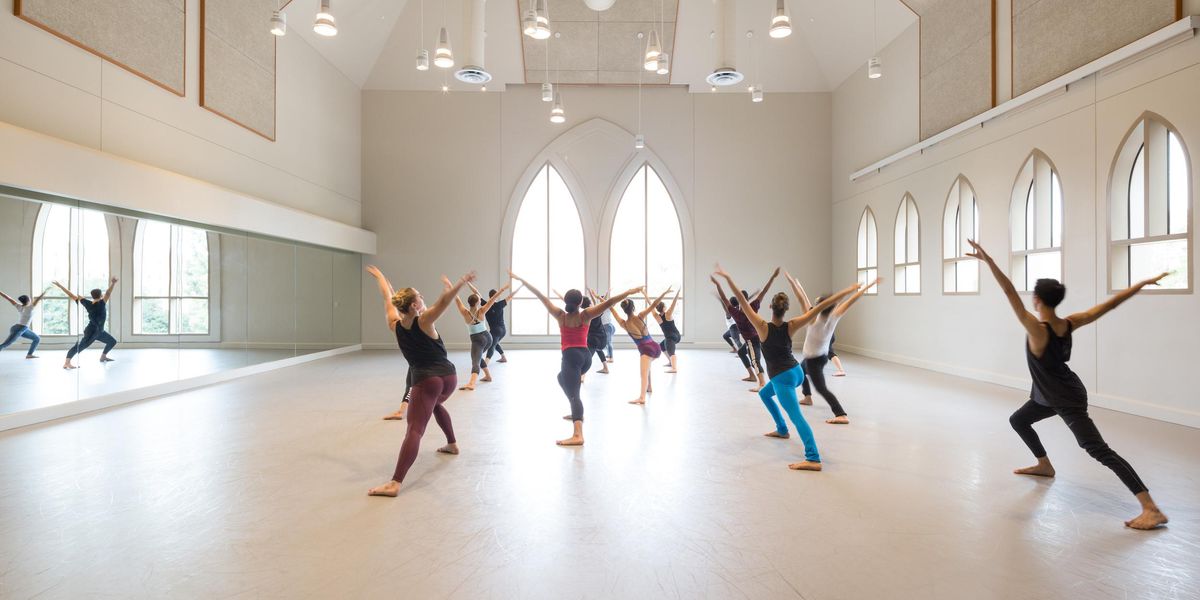Centerwork: Creation, Not Imitation
Steve Paxton leads a workshop at The Wooden Floor. Photo by Omar Galvez, Courtesy The Wooden Floor.
“Some of you are having trouble with coordination,” says the wiry man with the soft voice as he leads 18 young people through a series of exercises involving rolling shoulder blades, extended arms, and circling hipbones. “That’s good,” he continues with a chuckle, “otherwise I’d have nothing to do.”
This is not just any teacher, however, nor are these just any students. He’s legendary postmodern dancer/choreographer Steve Paxton, creator of contact improvisation and a co-founder of the seminal Judson Dance Theater. And while Paxton has been teaching his workshop “Material for the Spine” to dancers throughout the U.S. and in Europe, guiding this type of student is a first for him. Paxton’s class, a system for exploring the muscles of the back, was given under the auspices of The Wooden Floor, a Southern California nonprofit organization that provides tutoring, academic services, counseling, and dance education to low-income, mostly Latino youth.
“I’m seeing amazing students who are completely open,” says the 73-year-old Paxton. “They’ve been through a lot and I want to give them sensations that they perhaps haven’t had before—an exploration of the central spine, concepts of chi, and things that are basic but often unexamined, like gravity.”
He adds, “When I look at performers, I’m looking for authenticity and commitment to the task at hand. That’s what these students show.”
Founded in 1983, The Wooden Floor offers free classes in contemporary and improvisational techniques to 375 students who are admitted between ages 8 and 13; each student is expected to stay 10 years. A hundred percent of The Wooden Floor graduates go on to college. The organization also commissions choreographers to make new works on the students, who then perform in annual concerts.
“Because they have consistent contact with artists making work collaboratively with them,” says Melanie Ríos Glaser, a choreographer and The Wooden Floor’s artistic director, “they’re learning all the skills of making art—not just by imitation, but by creation. They develop critical thinking skills, spatial relationships, working as a team, openness, and having to reach inside and find some self-awareness to produce and contribute to the work.”
Ríos Glaser says she chooses choreographers who are actively contributing to the field—a roster that has included Susan Rethorst, Mark Haim, and John Heginbotham—and whose process will resonate with the students. “It’s complex, challenging work that does not condescend to the youth,” she says. “Steve Paxton has always been a person I’ve admired from afar and who influenced me tremendously. I reached out to him and said, ‘You have to erase every idea of dance-for-youth programs to understand The Wooden Floor.’ I sent him samples of the work and he got it.”
Paxton, who lives on a farm in northern Vermont, came to The Wooden Floor in part to see how the organization operates and why it has such a great effect on the students’ lives. “Here you have people who are really bright but they’re disadvantaged. I’m interested that this is a dance-centered educational facility, because physical activity is being eliminated from so many schools and so many schools are not turning out students who go to college. We’re seeing something here that’s very special—like Judson,” adds Paxton. “It’s not too clearly understood how centers of creativity occur, it seems like it just happens, but I’m very interested and we need this.”
Paxton taught a daily, three-hour workshop for two weeks in March. His calm demeanor, probing insights, and easy way with the students brought fruitful results. From floor movements that exercised the sacrum to visualizing the shapes of bones and cartilage, the body was worked in new, exciting ways.
As students rolled up to a sitting position in one class, Paxton explained, “The head is the last thing up. You have to design the body through the exercise. What is design? You’ve got a lot of possibilities. You’ve got a task to do.”
Kerlly Castellano, a student at The Wooden Floor since she was 12, was recently offered a scholarship to Boston University. The 18-year-old says that The Wooden Floor has been inspirational. “It’s what keeps me going every day. It’s a stress release, especially from school and all of the things going on outside. I get to relax and forget about everything and just focus on one thing.”
As for taking Paxton’s workshop, Castellano gushes, “It’s a huge, huge honor to be able to work with Steve Paxton. It’s also rewarding to come here and be treated like a real adult by all the teachers and learn new techniques and put that into work every single day.”
John Heginbotham, a dancer and choreographer who has performed with Mark Morris since 1998 (see his “Why I Dance,” Jan.), knew Ríos Glaser from Juilliard. Last year, she invited him to make a work, which resulted in Pieces of Wood, a dance for 97 students set to music of Steve Reich. The experience proved so rewarding that he returned this year to choreograph another piece, Promenade.
“I’m thrilled to be back, because these kids are fabulous,” he says. “They’re also kids—they’re messing around some of the time, but at heart they’re excited, they have imagination, they have humor.”
“It’s very moving to be part of a group that is all working towards the same thing,” adds Heginbotham, “which is to make something really good, and beautiful, and to have a great time. Everybody here is working toward that.”
Victoria Looseleaf contributes to the
Los Angeles Times and KUSC-FM radio. She teaches dance history at USC.




